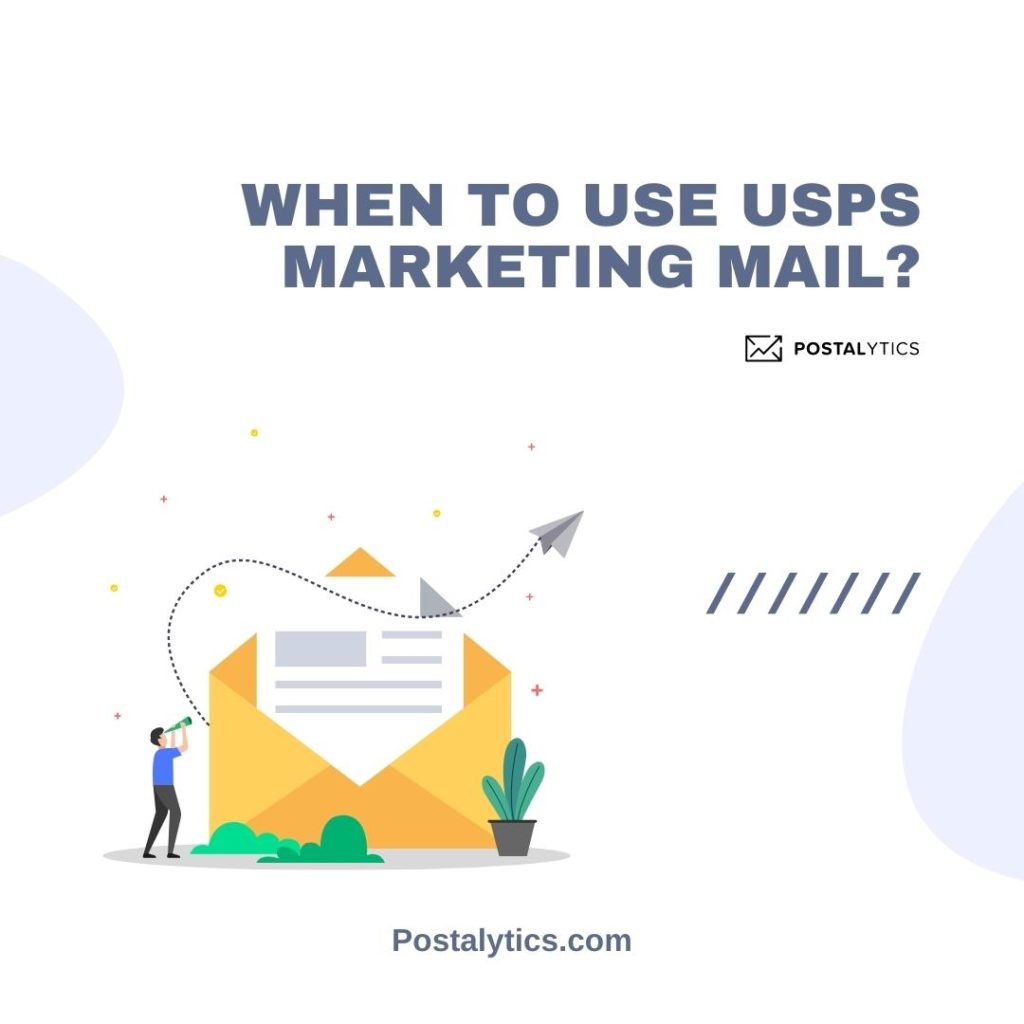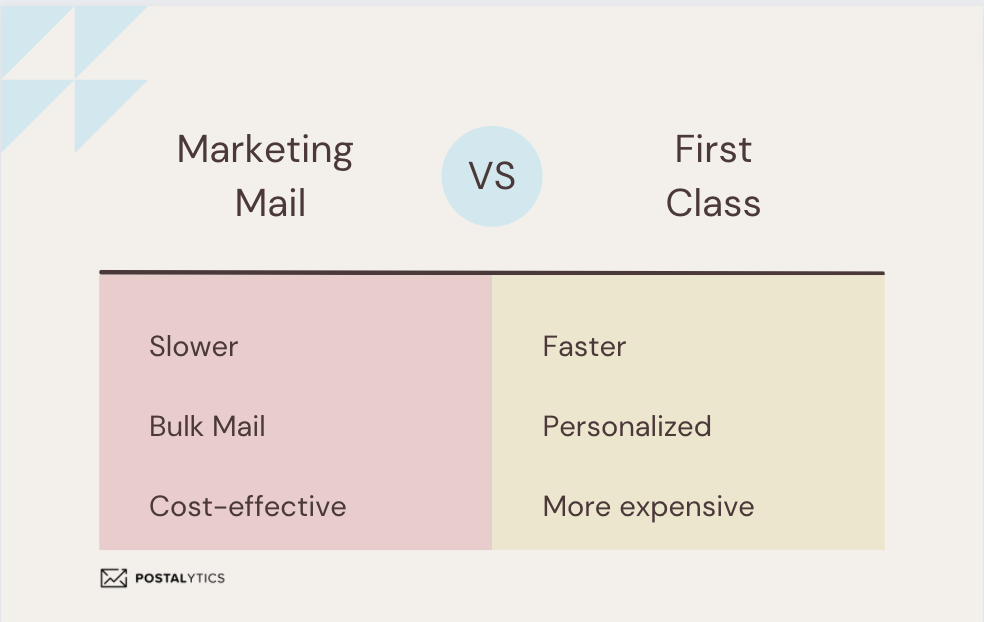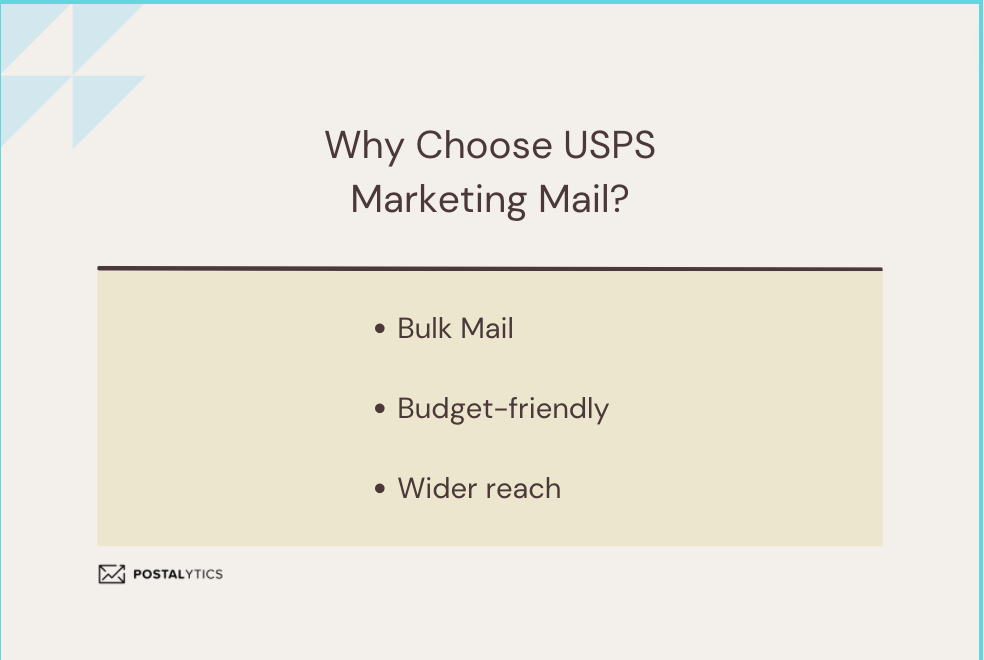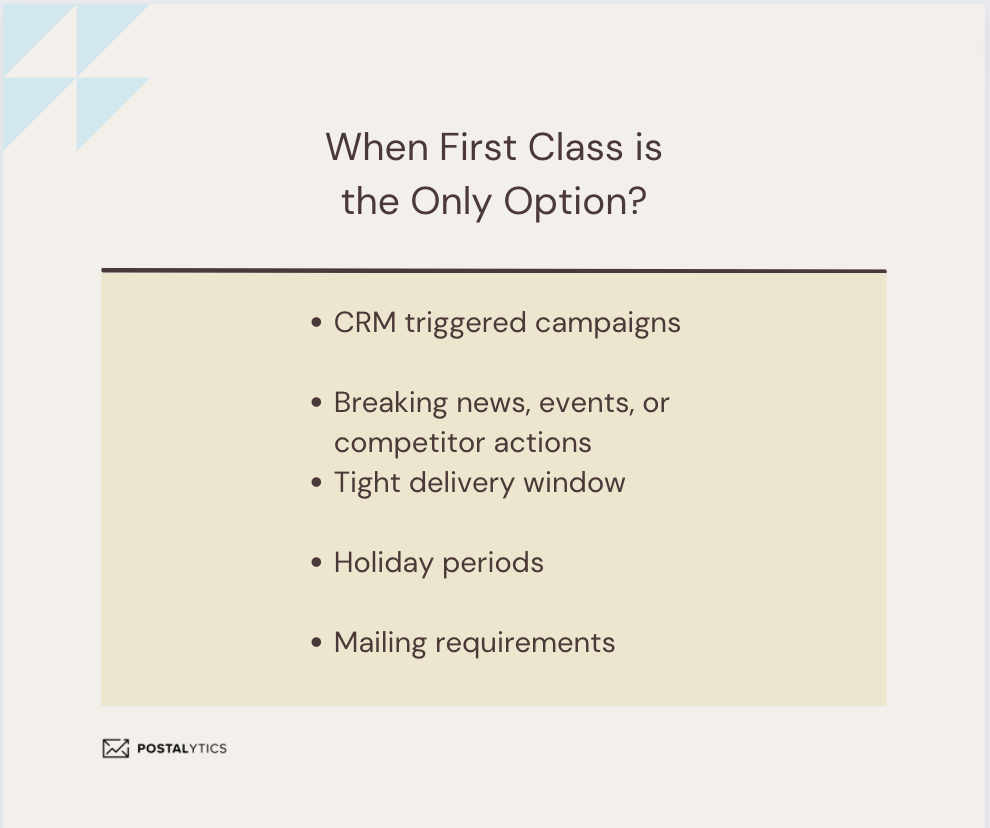
US Postal Service mailing classes can be pretty complicated. To make the mail move efficiently and at a low cost, the USPS has established lots of rules and regulations that determine the mailing class of your mailpieces and how you must configure and prepare the mail. Fortunately, mail classification is not something an average businessperson or marketer needs to spend their time studying. Mailing professionals, automated mailing software and print service providers can assist you with the decision making process between USPS Marketing Mail and USPS First Class Mail products.
Sometimes you have a choice about which mailing class is best for your campaigns, though, and it pays to have a basic understanding of the differences in relevant mailing classes. Making the wrong decision can have a big impact on your costs and the performance of your campaigns.
Marketers sending letters and postcards must choose between two classifications: USPS Marketing Mail and First Class.
Table of contents
What’s the Difference?

Part of the confusion about mail classes is how they are named. What we’ve known as Marketing Mail since 2017 used to be called Standard Mail and many people still use this terminology (as do the USPS internal systems). Before that, we called it Third Class. The USPS has updated the name over the years to match the way mailers are using the service.
First Class, however, has been used to describe the premier level of service in postal delivery since the mid-1800s. No name confusion there, but rules, services, and specifications do change from time to time.
Mailers use USPS Marketing Mail for items like advertising flyers, circulars, newsletters, bulletins, catalogs, and small parcels. The advantage of Marketing Mail for these types of communication is cost. Mailers will spend about 30% less on Marketing Mail postage compared to First Class.
As a result of the cost savings, Marketing Mail is often used for larger lists or for direct mail campaigns where the timing of delivery is less important.
Marketers use First Class for other types of mail as well, such as CRM triggered mail, greeting cards, personal correspondence, and any time delivery speed is important. That’s why First Class mail is often used for transactional documents like bills, notices, and statements.
USPS Marketing Mail Postage Cost
The postal service sets postage prices for USPS Marketing Mail letters, flats, or parcels. Rates normally adjust once per year, but sometimes the USPS changes rates more often. For postage calculations, the USPS prices Marketing Mail postcards the same as letters.
Non-profit rates apply only to Marketing Mail. The USPS offers no non-profit postage discounts on First Class mail, but authorized non-profit mailers can send Marketing Mail at a cost lower than regular Commercial Marketing Mail.
Both Marketing Mail and First Class offer workshare postage discounts. These discounts reduce postage rates when mailers follow certain rules about address accuracy and move update processing. With enough volume, mailers are granted discounts for sorting and preparing the mail in ways that reduces handling for the US Postal Service. Postalytics customers automatically share in these discounts. We perform all the address quality work before generating a mailing and qualify for presort discounts through the combined volumes of all the mail we produce.
Delivery Speed
The drawback to Marketing Mail is speed. Unlike First Class, Marketing Mail has no delivery standards to which the postal service is committed. The USPS processes Marketing Mail “as time allows”. It can take over twenty days for marketing mail to reach recipients, depending on the distance the mail must travel.
During the peak mailing season between Thanksgiving and New Year, delivery of marketing mail typically slows. In-home dates for materials mailed during the holidays become more difficult to predict.
Under the most recent USPS delivery guidelines, First Class mail should be delivered within the continental United States in one to five days, depending on the distance traveled. Local Marketing mail can take two to ten days during normal postal volume loads but may take longer. Delivery times for marketing mail lengthen as mail travels further from the inception point.
Other Differences
Another important point to understand about USPS Marketing Mail is the minimum mailing size requirement. Marketing Mailings must include at least 200 pieces of mail. There is no such thing as a single piece rate for Marketing Mail.
Postalytics actually enables marketers to send out Marketing Mail campaigns with less than 200 pieces. You can learn more about that here: https://www.postalytics.com/blog/direct-mail-with-no-minimum/
Sending campaigns as Marketing Mail also excludes the mailpieces from the free forwarding or return services included in First Class. Without ancillary endorsements and extra fees, the USPS destroys undeliverable Marketing Mail with no notification to the mailer.
Given the drawbacks of Marketing Mail, why would you use it?
Why Choose USPS Marketing Mail?

Mailers choose the Marketing Mail classification because of the cost. For large mailings, the postage savings can be substantial. If timing is not critical and you aren’t concerned about forwarding or return of undeliverable pieces, Marketing Mail can be a great strategy. You can apply the money you save on postage to widen the audience and mail to more potential customers.
Marketing mail is great for material not dependent on a tight window for delivery. Though no official standards exist, mailers can estimate delivery times and calculate their mailing dates accordingly. Mailing professionals know approximately how long it takes for mail to travel from sender to recipient based on experience. The USPS even maintains an interactive map that helps mailers predict the in-home dates of mail according to the post office where the mail enters the system. Here is a link to the USPS Current Standards Map: https://postalpro.usps.com/ppro-tools/service-standards-maps.
You may have noticed that some USPS Marketing Mail you receive at your home or office seems to be tied to a particular date such as a sale or event. This seems contradictory to the above comments about Marketing Mail’s lack of delivery standards. In many cases where delivery predictability is important, mailers prepare the mail in a manner to be turned over to the USPS at locations close to the recipients. They pay to ship pallets of mail to the selected USPS facilities via private trucks. This shortens the travel distance for the postal service and increases the chances for marketers to get their Marketing Mail into homes within the desired times. This process, known as drop shipping, is generally only used by large national mailers.
When First Class is the Only Option

Sometimes USPS Marketing Mail just is not a choice. Here are some cases where First Class is required or highly recommended.
- Triggered mailings from your CRM — Unlike mass mail campaigns, triggered mail almost always consists of small volumes. With Postalytics, you can even send a single piece. Clearly, this doesn’t meet the criteria for the minimum Marketing Mail volumes. There’s another reason you wouldn’t want to send triggered mail by any means other than First Class. The triggering event may be a date, such as an expiration date or a birthday. Or the trigger might be some recent action taken by your customer, such as visiting your website or downloading some content. You’ll want to respond to these events as quickly as possible. First Class is the only way.
- Response to breaking news, events, or competitor actions — Mailings prompted by unexpected actions are frequently urgent. You don’t have time to plan ahead and make allowances for Marketing Mail’s longer delivery times. If some mail can’t be delivered as addressed, you may want the USPS to forward it or notify you so you can reach customers through an alternate channel. These services are included in First Class.
- Tight delivery window — If it’s important that your mail arrive in home within a defined time span, First Class is the method to use. A good example might be election mail. If you want your mail to arrive just a few the days before election day, you wouldn’t want to risk some of it being delivered after the election because it languished in a postal facility as lower priority Marketing Mail.
- Holiday period — The busiest time for the US Postal Service is the period between Thanksgiving and New Year’s Day. All the First Class holiday packages and cards take priority, which could cause your mail to sit on a dock, unmoving for a long time. If you are mailing during the holidays, we strongly recommend you consider First Class. You can return to Marketing Mail once the surge in postal volume subsides.
- Mailing requirements — The USPS prohibits some mail from being classified as Marketing Mail. The content of the communications matters. You cannot send bills or statements as Marketing Mail, for example, and there are rules about how much personal information you can include in the mailpiece. When in doubt, contact Postalytics or check with a Mailpiece Design Analyst from the USPS.
Choosing between USPS Marketing Mail and First Class is easy once you understand the differences in cost, regulations, service levels, and delivery times. Usually, the answer is obvious. When it’s not, contact your Postalytics representative for advice. We can help you weigh the pros and cons of each mailing class.
To make things even easier, Postalytics includes an interactive tool that estimates the in-home dates and costs of each mailing class.
You’ll have access to this tool as you prepare your campaigns in Postalytics.
For more discussion of mailing classes, see this article from our blog:
https://www.postalytics.com/blog/first-class-vs-standard-class-direct-mail/.
About the Author

Dennis Kelly
Dennis Kelly is CEO and co-founder of Postalytics, the leading direct mail automation platform for marketers to build, deploy and manage direct mail marketing campaigns. Postalytics is Dennis’ 6th startup. He has been involved in starting and growing early-stage technology ventures for over 30 years and has held senior management roles at a diverse set of large technology firms including Computer Associates, Palm Inc. and Achieve Healthcare Information Systems.
